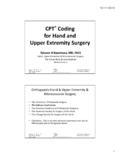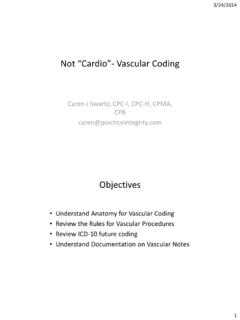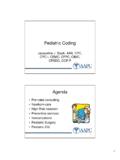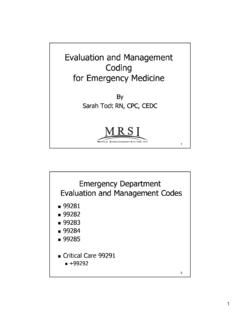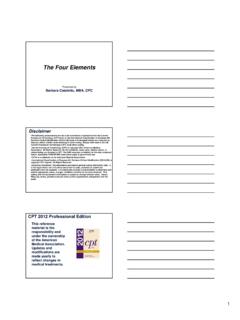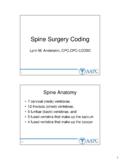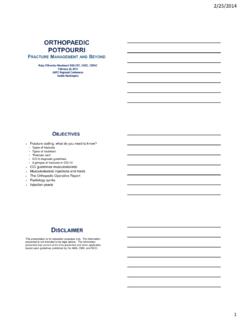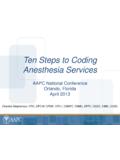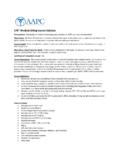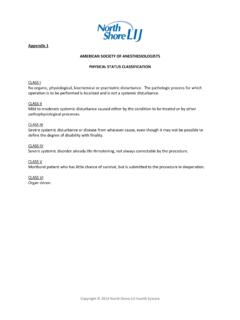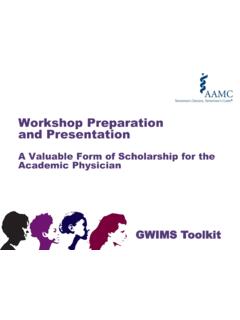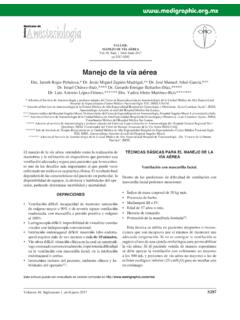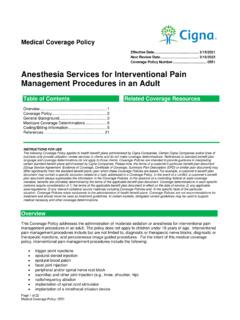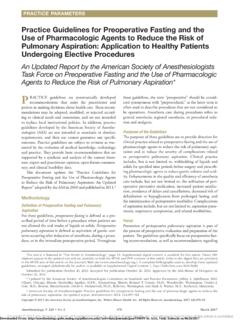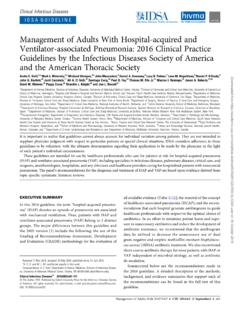Transcription of The Basics of Anesthesia Billing.
1 1 The Basics of Anesthesia A. Wilson, CPC,CPC-H,CPC-P,CPC-I,CANPC,CMBSI,CMRSD isclosures This presentation is intended to provide basic ppeducational information regarding coding/billing for Anesthesia and not intended to convey coding advice and does not represent the following: Official policy of the ASA ( american society of Anesthesiologists) Official policy of the Virginia CMS Every effort has been made to assure the information in this presentation is accurate2 Medicine s Greatest Gift Over one hundred fifty years ago, at Massachusetts GlHitl fth tttiGeneral Hospital, one of the greatest moments in medicine occurred. October 16, 1846 William Morton, A Boston dentist, demonstrated the use of ether during surgery, ending indescribable pain and the overwhelming dread that had been associated with the surgeon s knife. Dr. Morton was not the first to use ether during a surgery, Dr.
2 Ggy,Crawford Williamson Long use it in 1842 to remove a tumor. Because Long did not publish or publicize his work, Dr. Morton usually gets credit for the discovery of s Greatest Gift Continued Dr. Morton used ether on a patient while extracting a tooth. The patient was so impressed that they went to the local newspaper. Dr. Morton was urged to demonstrate the use of ether during an operation at Massachusetts General Hospital. He used a specially designed glass inhaler containing an ether-soaked sponge to administer the anesthetic to the patient, Gilbert Abbott, who was in the hospital clinic for treatment of a vascular tumor on his s Greatest Gift Continued After several minutes, the patient was unconscious. pThe surgeon John Collins Warren MD, one of the most widely recognized surgeons of the time, surgically removed the tumor. The patient upon wakening informed the curious and skeptical physicians and medical students that he had id NO PAIN D Wt ld thexperienced NO PAIN.
3 Dr. Warren told the onlookers as they were taking the patient out, Gentlemen, this is no humbug. A new era of Medicine had Does Anesthesia Work? One of the most often asked question is how does th ik? Thtiik d ianesthesia work? The question is asked in a way that makes it clear that Anesthesia is thought of as a single entity, one medication or one technique. This is a common misconception among patients. While it seems impossible to believe that with today s advanced scientific knowledge andtoday s advanced scientific knowledge and experimental techniques, it is true that the mechanism of many medications used in Anesthesia are simply not Anesthesiology is a practice of medicine gypspecializing in: The management of patients who are rendered unconscious and/or insensible to pain and emotional stress during surgical, obstetrical, and certain other medical procedurespAnesthesiology (Cont) The management of problems in pain reliefgp p The management of cardiopulmonary resuscitation The management of problems in pulmonary care The management of critically ill patients in special care unitsspecial care units5 Types of Anesthesia There are four broad categories of Anesthesia that can be dused.
4 Local Anesthesia Is the term used when injections of local anesthetic drugs are used to block sensation to a very small and specific area of the body. This usually involves the injections of anesthetic drug with a needle. There are other ways of delivering local anesthetic drugs-injection is still the most common method of delivery. It works by blocking nerve impulses. When the nerve is blocked it cannotblocking nerve impulses. When the nerve is blocked it cannot conduct an impulse and therefore no sensation can be of Anesthesia Regional Anesthesiag Regional Anesthesia involves the injection of local anesthetic drugs in such a way that a large number of nerves are blocked. This results in a large region of the body without sensation. It is similar to local Anesthesia but has a larger effect. g(example: Epidurals for delivery)6 Types of Anesthesia MAC/Sedation Can be accomplished with a variety of medications.
5 Most of the time, they are given through an intravenous line directly into the bloodstream. It is like a general on a smaller level. Patient can usually answer questions and yqfollow direction given by the of Anesthesia General Renders the patient unconscious and unable to respond to touch or of Anesthesia Providers Anesthesiologist Certified Register Nurse Anesthetist (CRNA) Must accept assignment May work without the oversight of an anesthesiologist Anesthesiologist s Assistant Must accept assignment May not work without the oversight of the anesthesiologistanesthesiologist Resident Never bill for Student registered nurse anesthetistCode Sets Procedural codingg CPT more than 60,000 codes ASA RVG (Relative Value Guide) (adopted by Medicare in 1987) about 300 codes Anesthesia Crosswalk Cross walks CPT codes to Anesthesia codes HIPAA requires the use of CPT as the code set Which part Anesthesia Surgery8 How Does Anesthesia Get Paid?
6 Base Units + Time Units + Modifying UnitsNational Anesthesia Conversion FactorFVi i i 2010 For Virginia 2010 $ per unitfor Par Physician $ per unitfor Non Par Physician Effective June 1, 20109 Base Units Sources ASA Relative Value Guide ASA Crosswalk Others Bill only the highest base unit procedure Medicare Base units can be different than ASAM edicare Base units can be different than ASA RVG; you should know what the base units are for Medicare in your area because sometimes the base unit will be higher than the ASA under the Base Units A basic value is listed for anesthetic management of most ildThiild th l f lllsurgical procedures. This includes the value for all usual Anesthesia services except the time actually spent in Anesthesia care and any modifiers. The usual Anesthesia services included in the Basic Value include the usual pre-operative and post-operative visits, the administration of fluids and/or blood products incident to the Anesthesia care and interpretation of non-invasive monitoring (ECG, bld) Plfi lltemperature, blood pressure, etc.
7 Place of arterial, central venous and pulmonary artery catheters and use of transesophageal echocardiography (TEE) are not included in the basic unit TimePer Medicare Anesthesia Manual Anesthesia time begins when the anesthesiologist starts to prepare the patient for the procedure. Normally, this service takes place in the operating room, but in some cases, preparation may begin in another location ( , holding area). Anesthesia time is a continuous time period from the start of Anesthesia to the end of an Anesthesia service. Start Time (Cont) When the anesthesiologist starts preparing the gppgpatient for induction or when the patient is under the care of an Anesthesia provider Present, refers to the Anesthesia provider being in constant contact with the patient 11 Start Time (Cont) Show an action on the Anesthesia record indicating time Must show documentation of activity on the Anesthesia record Vital sign ProcedureStart Time (Cont)
8 The time on the Anesthesia record and the time that is billed should match The time on the doctor s claim and the CRNA claim should match12 Anesthesia Time You need to remember that if there is a break in the Anesthesia time you can not bill for that time Anesthesia provider can add blocks of time around an interruption in Anesthesia time as lhifihitithilong as he is furnishing continuous Anesthesia care within the time periods around the interruptionsTime Units Never round times Time increments Medicare-fifteen minute units Paid at one-tenth of a minute increment Commercial insurance- other specified time units Ten, fifteen or twelvee ,tee o twe ve Why use different units? Usually paid in whole units. Rounded to the next unit13 Stop Time When the patient can be safely turned over to pya non- Anesthesia provider Never happens in the operating roomDiscontinuous Time Use when Anesthesia is Surgeon is delayed From Medicare Manual: For services on or after Jan.
9 01, 2000, the Anesthesia provider can add blocks of time around an interruption in Anesthesia time, as long as the anesthesiain Anesthesia time, as long as the Anesthesia provider is furnishing continuous Anesthesia care within the time periods around the interruption. 14 How to Document Discontinuous Time Your Anesthesia record should clearly show ywhen Anesthesia time starts and stops. Your total time billed should match the time blocks documented on the Anesthesia record. DON T USE DISCONTINUOUS FOR: Relief issues Broken medical direction, or when an anesthesiologist must leave in the middle of a caseUnusual Time Situations Extended Care Relief The Anesthesia provider with the longest time is the provider who will bill for the services. Example: Dr. A starts at 9:03 and Dr. B starts at 10 13d ttii 13 16 D Bld bill f10:13 and stop time is 13:16, Dr.
10 B would bill for the entire time 9:03 - 13:16 as he was the doctor with the longest time on the case. 15 Modifier Types Physical status Most insurance P1= normal healthy patient = 0 units P2 patient with mild systemic disease = 0 units P3 = patient with severe systemic disease =1 unit P4 = pt. w/severe systemic that is a constant threat to life = 2 units P5 = a moribund pt who is not expected to survive without the operation = 3 units P6 = declared brain-dead pt whose organs are being removed for donor purposes Medicare No additional units paidModifier Types (Cont) Age = 99100 =1 unit Emergency = 99140= 2 units Hypotension = 99315 = 5 units Hypothermia = 99116 = 5 units Field avoidance = 2 units up to five base units total (May have to add a modifier like 22 for some (yinsurance companies) Unusual position = 2 units up to five base Medicare Not paid16 Modifiers (Cont))
